2014 BMW 335I XDRIVE GRAN TURISMO light
[x] Cancel search: lightPage 208 of 240
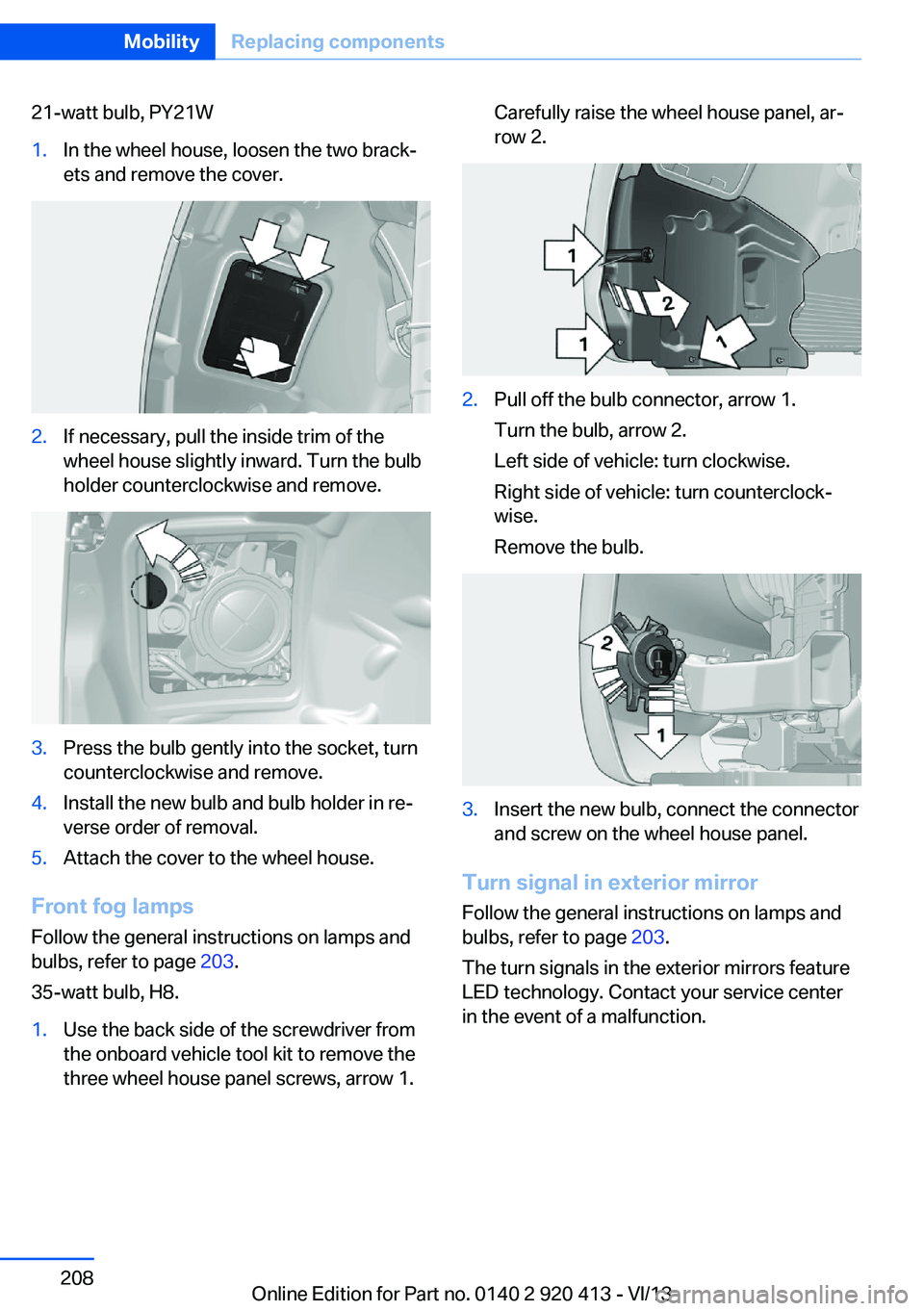
21-watt bulb, PY21W1.In the wheel house, loosen the two brack‐
ets and remove the cover.2.If necessary, pull the inside trim of the
wheel house slightly inward. Turn the bulb
holder counterclockwise and remove.3.Press the bulb gently into the socket, turn
counterclockwise and remove.4.Install the new bulb and bulb holder in re‐
verse order of removal.5.Attach the cover to the wheel house.
Front fog lamps
Follow the general instructions on lamps and
bulbs, refer to page 203.
35-watt bulb, H8.
1.Use the back side of the screwdriver from
the onboard vehicle tool kit to remove the
three wheel house panel screws, arrow 1.Carefully raise the wheel house panel, ar‐
row 2.2.Pull off the bulb connector, arrow 1.
Turn the bulb, arrow 2.
Left side of vehicle: turn clockwise.
Right side of vehicle: turn counterclock‐
wise.
Remove the bulb.3.Insert the new bulb, connect the connector
and screw on the wheel house panel.
Turn signal in exterior mirror
Follow the general instructions on lamps and
bulbs, refer to page 203.
The turn signals in the exterior mirrors feature
LED technology. Contact your service center
in the event of a malfunction.
Seite 208MobilityReplacing components208
Online Edition for Part no. 0140 2 920 413 - VI/13
Page 214 of 240
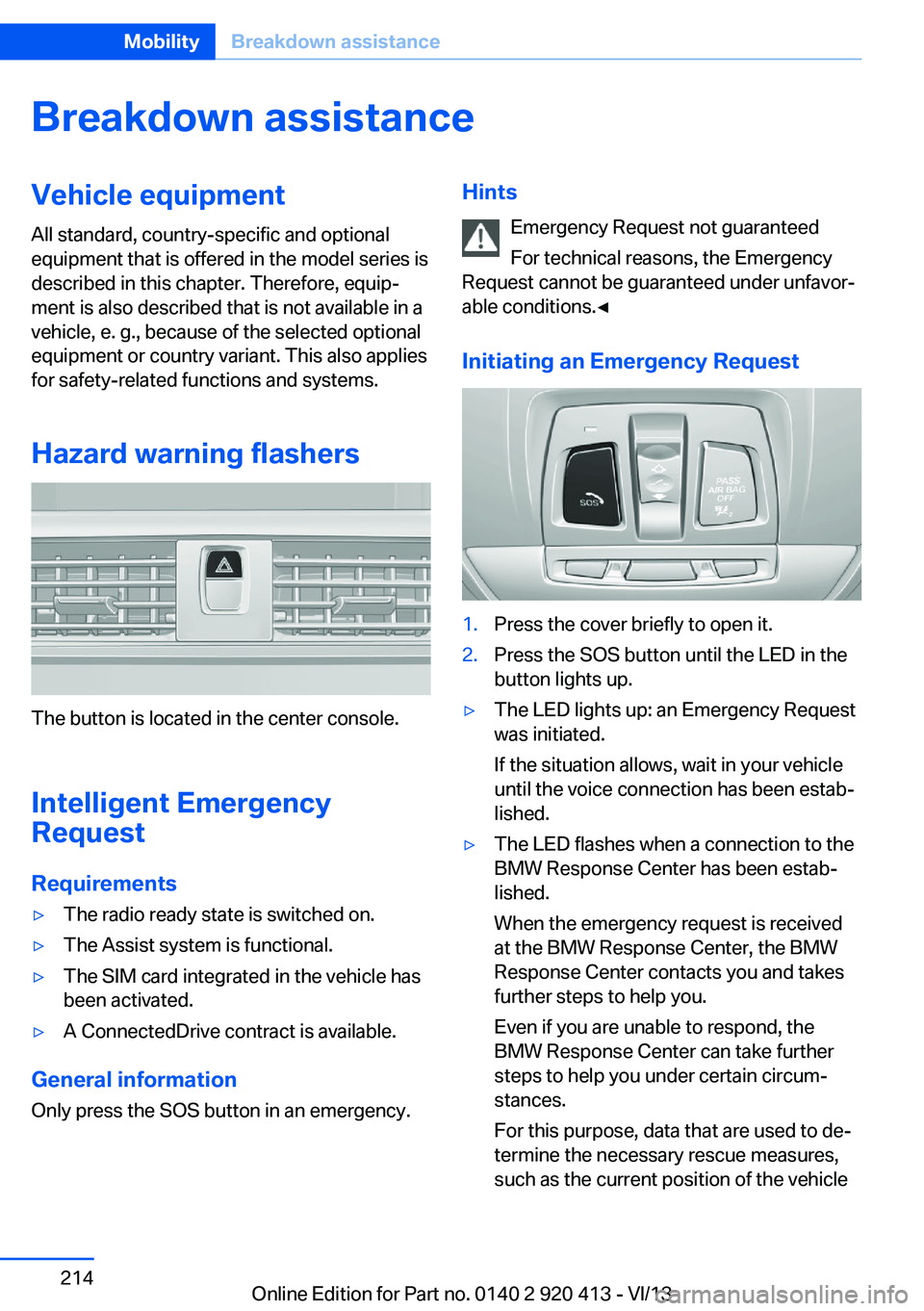
Breakdown assistanceVehicle equipment
All standard, country-specific and optional
equipment that is offered in the model series is
described in this chapter. Therefore, equip‐
ment is also described that is not available in a
vehicle, e. g., because of the selected optional
equipment or country variant. This also applies
for safety-related functions and systems.
Hazard warning flashers
The button is located in the center console.
Intelligent Emergency
Request
Requirements
▷The radio ready state is switched on.▷The Assist system is functional.▷The SIM card integrated in the vehicle has
been activated.▷A ConnectedDrive contract is available.
General information
Only press the SOS button in an emergency.
Hints
Emergency Request not guaranteed
For technical reasons, the Emergency
Request cannot be guaranteed under unfavor‐
able conditions.◀
Initiating an Emergency Request1.Press the cover briefly to open it.2.Press the SOS button until the LED in the
button lights up.▷The LED lights up: an Emergency Request
was initiated.
If the situation allows, wait in your vehicle
until the voice connection has been estab‐
lished.▷The LED flashes when a connection to the
BMW Response Center has been estab‐
lished.
When the emergency request is received
at the BMW Response Center, the BMW
Response Center contacts you and takes
further steps to help you.
Even if you are unable to respond, the
BMW Response Center can take further
steps to help you under certain circum‐
stances.
For this purpose, data that are used to de‐
termine the necessary rescue measures,
such as the current position of the vehicleSeite 214MobilityBreakdown assistance214
Online Edition for Part no. 0140 2 920 413 - VI/13
Page 217 of 240
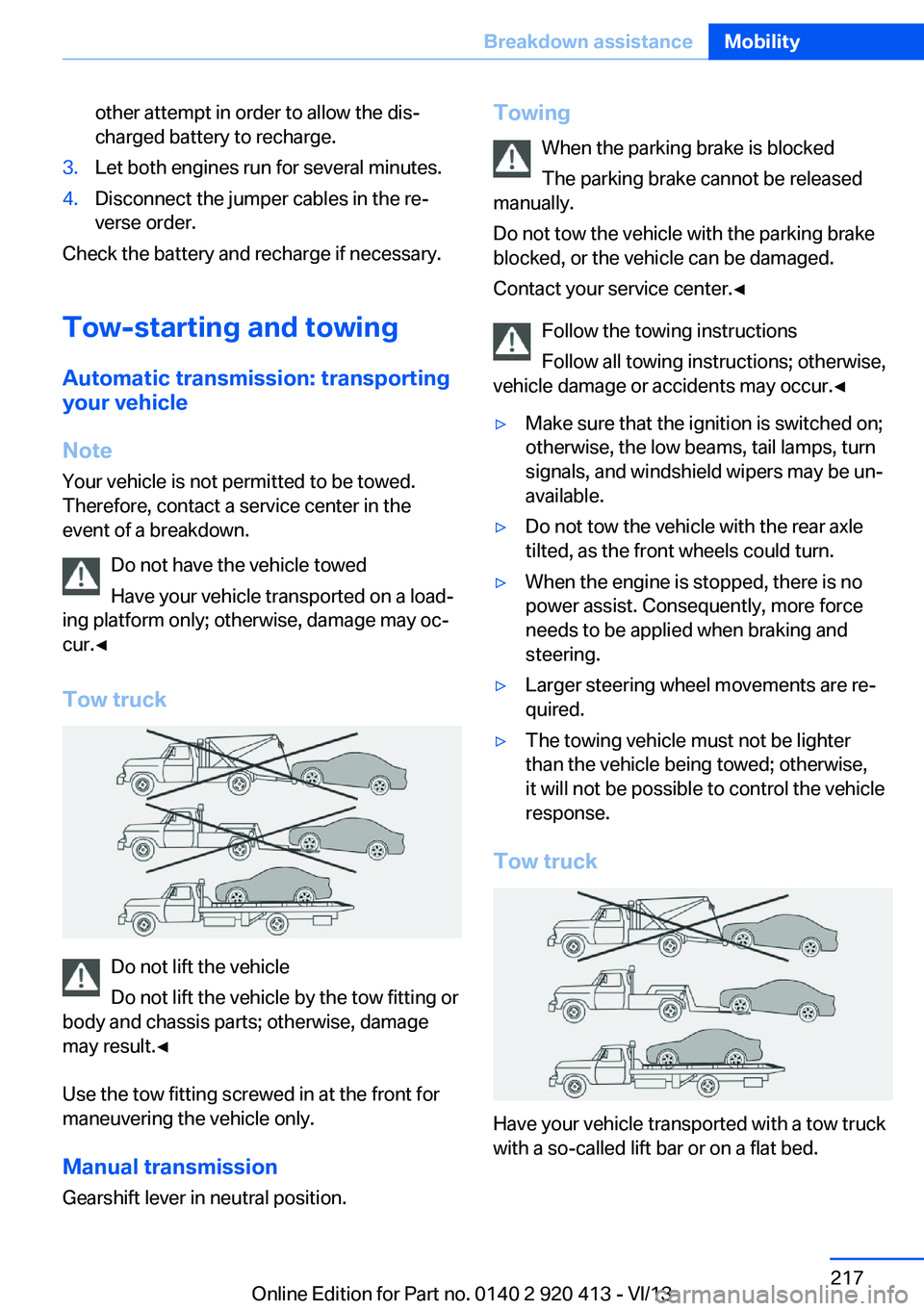
other attempt in order to allow the dis‐
charged battery to recharge.3.Let both engines run for several minutes.4.Disconnect the jumper cables in the re‐
verse order.
Check the battery and recharge if necessary.
Tow-starting and towing Automatic transmission: transporting
your vehicle
Note
Your vehicle is not permitted to be towed.
Therefore, contact a service center in the
event of a breakdown.
Do not have the vehicle towed
Have your vehicle transported on a load‐
ing platform only; otherwise, damage may oc‐
cur.◀
Tow truck
Do not lift the vehicle
Do not lift the vehicle by the tow fitting or
body and chassis parts; otherwise, damage
may result.◀
Use the tow fitting screwed in at the front for
maneuvering the vehicle only.
Manual transmission
Gearshift lever in neutral position.
Towing
When the parking brake is blocked
The parking brake cannot be released
manually.
Do not tow the vehicle with the parking brake
blocked, or the vehicle can be damaged.
Contact your service center.◀
Follow the towing instructions
Follow all towing instructions; otherwise,
vehicle damage or accidents may occur.◀▷Make sure that the ignition is switched on;
otherwise, the low beams, tail lamps, turn
signals, and windshield wipers may be un‐
available.▷Do not tow the vehicle with the rear axle
tilted, as the front wheels could turn.▷When the engine is stopped, there is no
power assist. Consequently, more force
needs to be applied when braking and
steering.▷Larger steering wheel movements are re‐
quired.▷The towing vehicle must not be lighter
than the vehicle being towed; otherwise,
it will not be possible to control the vehicle
response.
Tow truck
Have your vehicle transported with a tow truck
with a so-called lift bar or on a flat bed.
Seite 217Breakdown assistanceMobility217
Online Edition for Part no. 0140 2 920 413 - VI/13
Page 218 of 240
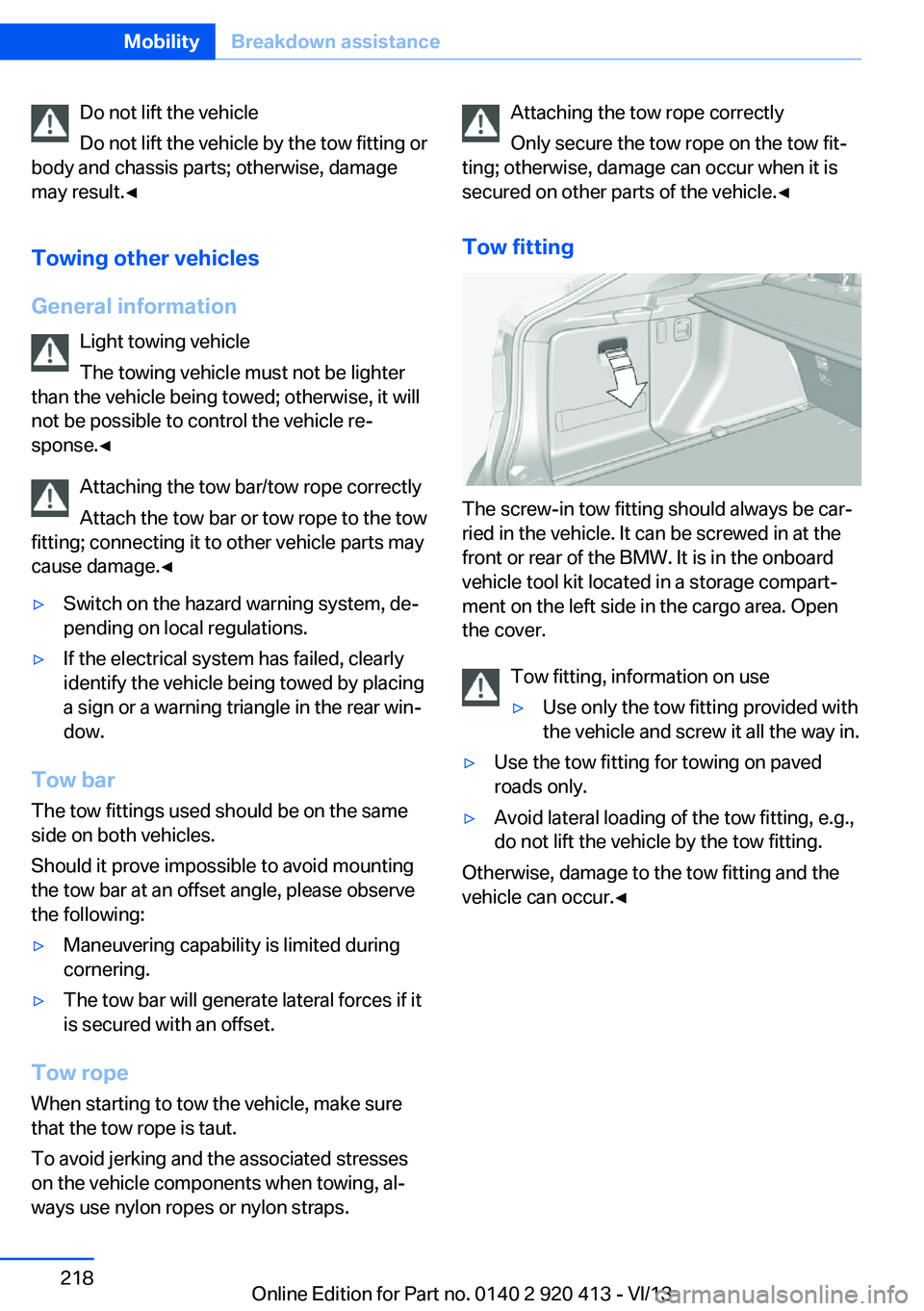
Do not lift the vehicle
Do not lift the vehicle by the tow fitting or
body and chassis parts; otherwise, damage
may result.◀
Towing other vehicles
General information Light towing vehicle
The towing vehicle must not be lighter
than the vehicle being towed; otherwise, it will
not be possible to control the vehicle re‐
sponse.◀
Attaching the tow bar/tow rope correctly
Attach the tow bar or tow rope to the tow
fitting; connecting it to other vehicle parts may
cause damage.◀▷Switch on the hazard warning system, de‐
pending on local regulations.▷If the electrical system has failed, clearly
identify the vehicle being towed by placing
a sign or a warning triangle in the rear win‐
dow.
Tow bar
The tow fittings used should be on the same
side on both vehicles.
Should it prove impossible to avoid mounting
the tow bar at an offset angle, please observe
the following:
▷Maneuvering capability is limited during
cornering.▷The tow bar will generate lateral forces if it
is secured with an offset.
Tow rope
When starting to tow the vehicle, make sure
that the tow rope is taut.
To avoid jerking and the associated stresses
on the vehicle components when towing, al‐
ways use nylon ropes or nylon straps.
Attaching the tow rope correctly
Only secure the tow rope on the tow fit‐
ting; otherwise, damage can occur when it is
secured on other parts of the vehicle.◀
Tow fitting
The screw-in tow fitting should always be car‐
ried in the vehicle. It can be screwed in at the
front or rear of the BMW. It is in the onboard
vehicle tool kit located in a storage compart‐
ment on the left side in the cargo area. Open
the cover.
Tow fitting, information on use
▷Use only the tow fitting provided with
the vehicle and screw it all the way in.▷Use the tow fitting for towing on paved
roads only.▷Avoid lateral loading of the tow fitting, e.g.,
do not lift the vehicle by the tow fitting.
Otherwise, damage to the tow fitting and the
vehicle can occur.◀
Seite 218MobilityBreakdown assistance218
Online Edition for Part no. 0140 2 920 413 - VI/13
Page 222 of 240
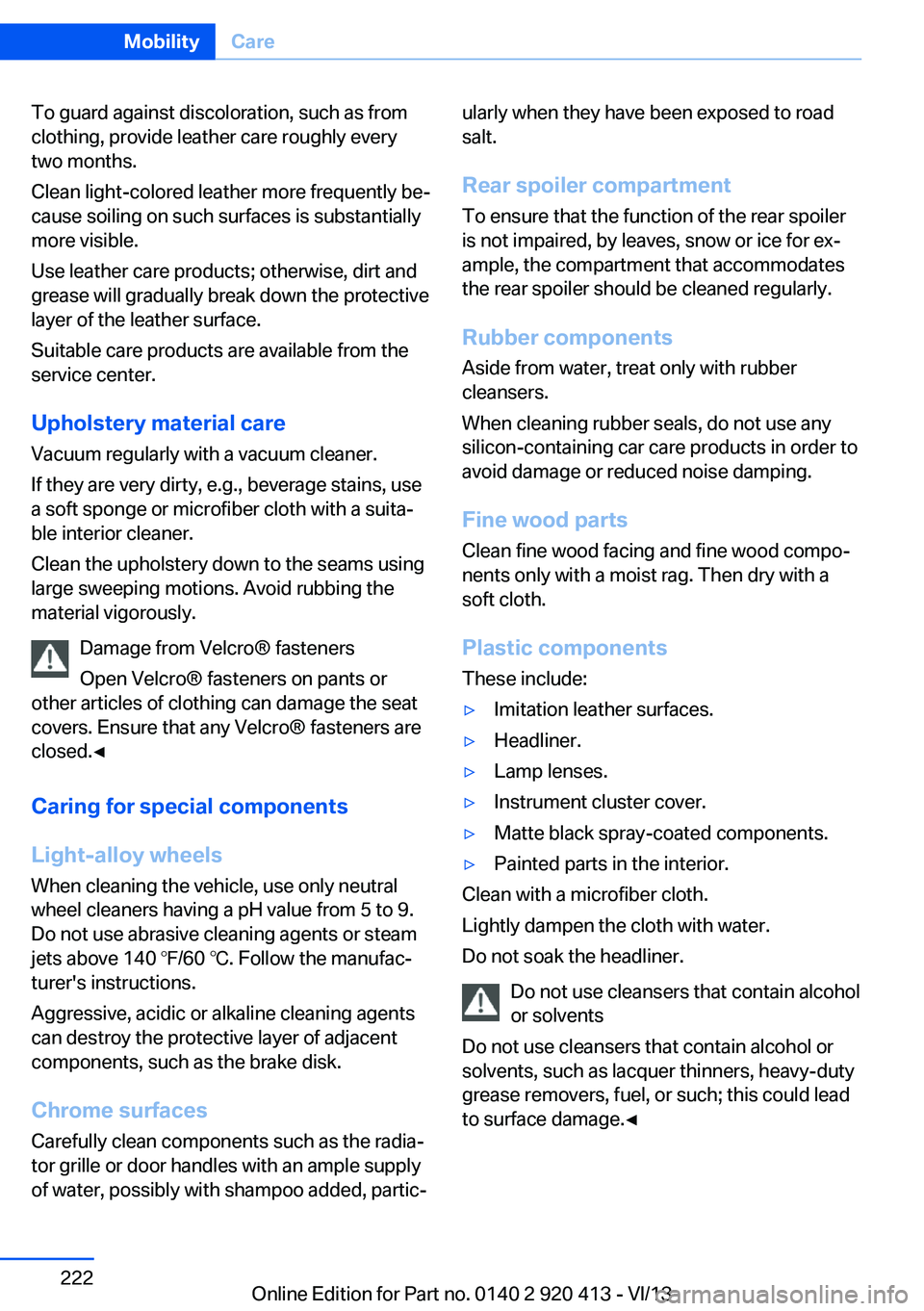
To guard against discoloration, such as from
clothing, provide leather care roughly every
two months.
Clean light-colored leather more frequently be‐
cause soiling on such surfaces is substantially
more visible.
Use leather care products; otherwise, dirt and
grease will gradually break down the protective
layer of the leather surface.
Suitable care products are available from the
service center.
Upholstery material care Vacuum regularly with a vacuum cleaner.
If they are very dirty, e.g., beverage stains, use
a soft sponge or microfiber cloth with a suita‐
ble interior cleaner.
Clean the upholstery down to the seams using
large sweeping motions. Avoid rubbing the
material vigorously.
Damage from Velcro® fasteners
Open Velcro® fasteners on pants or
other articles of clothing can damage the seat
covers. Ensure that any Velcro® fasteners are
closed.◀
Caring for special components
Light-alloy wheels When cleaning the vehicle, use only neutral
wheel cleaners having a pH value from 5 to 9.
Do not use abrasive cleaning agents or steam
jets above 140 ℉/60 ℃. Follow the manufac‐
turer's instructions.
Aggressive, acidic or alkaline cleaning agents
can destroy the protective layer of adjacent
components, such as the brake disk.
Chrome surfaces Carefully clean components such as the radia‐
tor grille or door handles with an ample supply of water, possibly with shampoo added, partic‐ularly when they have been exposed to road
salt.
Rear spoiler compartment To ensure that the function of the rear spoiler
is not impaired, by leaves, snow or ice for ex‐
ample, the compartment that accommodates
the rear spoiler should be cleaned regularly.
Rubber components
Aside from water, treat only with rubber
cleansers.
When cleaning rubber seals, do not use any
silicon-containing car care products in order to
avoid damage or reduced noise damping.
Fine wood parts Clean fine wood facing and fine wood compo‐
nents only with a moist rag. Then dry with a
soft cloth.
Plastic components
These include:▷Imitation leather surfaces.▷Headliner.▷Lamp lenses.▷Instrument cluster cover.▷Matte black spray-coated components.▷Painted parts in the interior.
Clean with a microfiber cloth.
Lightly dampen the cloth with water.
Do not soak the headliner.
Do not use cleansers that contain alcohol
or solvents
Do not use cleansers that contain alcohol or
solvents, such as lacquer thinners, heavy-duty
grease removers, fuel, or such; this could lead
to surface damage.◀
Seite 222MobilityCare222
Online Edition for Part no. 0140 2 920 413 - VI/13
Page 230 of 240
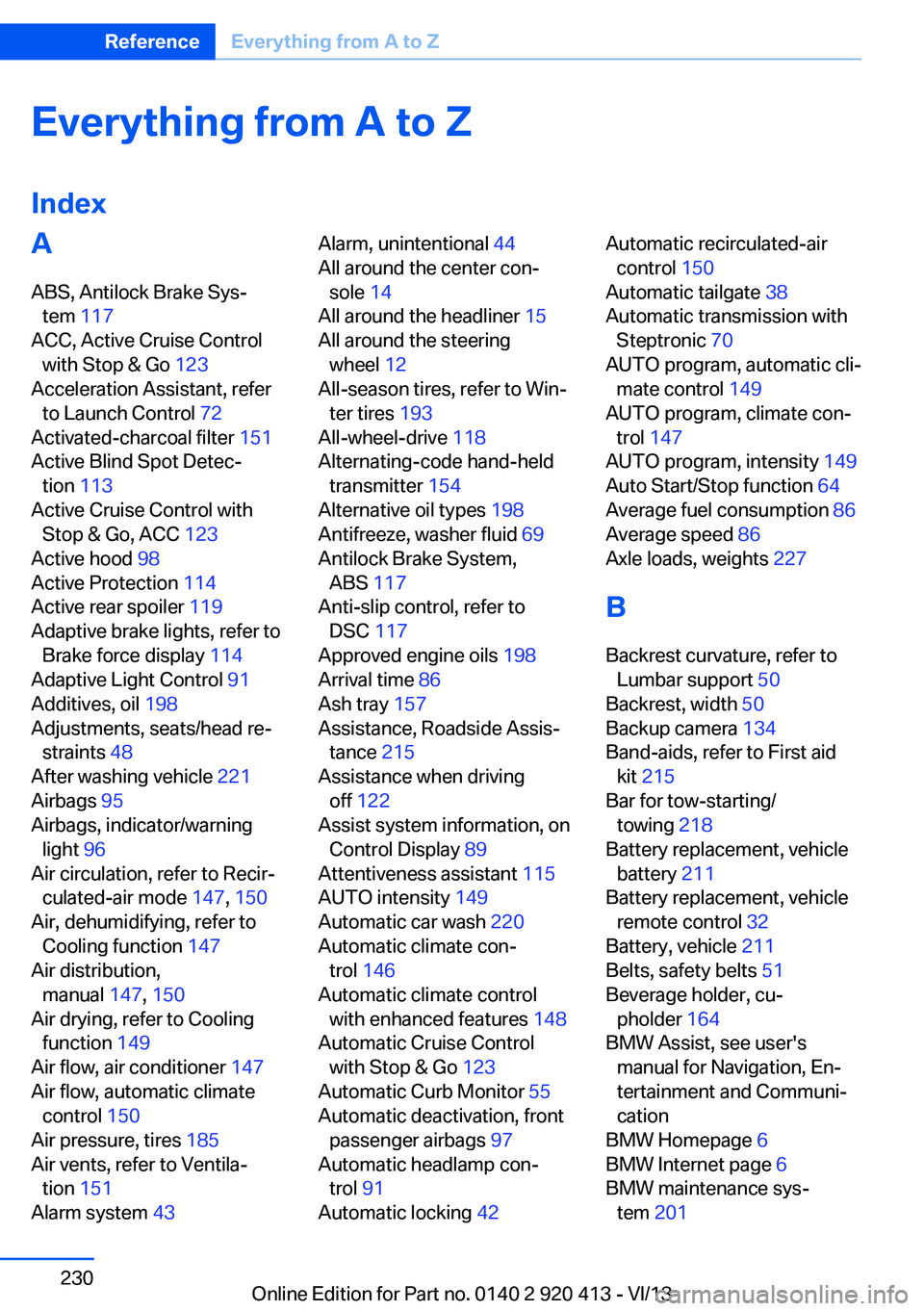
Everything from A to Z
IndexA ABS, Antilock Brake Sys‐ tem 117
ACC, Active Cruise Control with Stop & Go 123
Acceleration Assistant, refer to Launch Control 72
Activated-charcoal filter 151
Active Blind Spot Detec‐ tion 113
Active Cruise Control with Stop & Go, ACC 123
Active hood 98
Active Protection 114
Active rear spoiler 119
Adaptive brake lights, refer to Brake force display 114
Adaptive Light Control 91
Additives, oil 198
Adjustments, seats/head re‐ straints 48
After washing vehicle 221
Airbags 95
Airbags, indicator/warning light 96
Air circulation, refer to Recir‐ culated-air mode 147, 150
Air, dehumidifying, refer to Cooling function 147
Air distribution, manual 147, 150
Air drying, refer to Cooling function 149
Air flow, air conditioner 147
Air flow, automatic climate control 150
Air pressure, tires 185
Air vents, refer to Ventila‐ tion 151
Alarm system 43 Alarm, unintentional 44
All around the center con‐ sole 14
All around the headliner 15
All around the steering wheel 12
All-season tires, refer to Win‐ ter tires 193
All-wheel-drive 118
Alternating-code hand-held transmitter 154
Alternative oil types 198
Antifreeze, washer fluid 69
Antilock Brake System, ABS 117
Anti-slip control, refer to DSC 117
Approved engine oils 198
Arrival time 86
Ash tray 157
Assistance, Roadside Assis‐ tance 215
Assistance when driving off 122
Assist system information, on Control Display 89
Attentiveness assistant 115
AUTO intensity 149
Automatic car wash 220
Automatic climate con‐ trol 146
Automatic climate control with enhanced features 148
Automatic Cruise Control with Stop & Go 123
Automatic Curb Monitor 55
Automatic deactivation, front passenger airbags 97
Automatic headlamp con‐ trol 91
Automatic locking 42 Automatic recirculated-air
control 150
Automatic tailgate 38
Automatic transmission with Steptronic 70
AUTO program, automatic cli‐ mate control 149
AUTO program, climate con‐ trol 147
AUTO program, intensity 149
Auto Start/Stop function 64
Average fuel consumption 86
Average speed 86
Axle loads, weights 227
B Backrest curvature, refer to Lumbar support 50
Backrest, width 50
Backup camera 134
Band-aids, refer to First aid kit 215
Bar for tow-starting/ towing 218
Battery replacement, vehicle battery 211
Battery replacement, vehicle remote control 32
Battery, vehicle 211
Belts, safety belts 51
Beverage holder, cu‐ pholder 164
BMW Assist, see user's manual for Navigation, En‐
tertainment and Communi‐
cation
BMW Homepage 6
BMW Internet page 6
BMW maintenance sys‐ tem 201 Seite 230ReferenceEverything from A to Z230
Online Edition for Part no. 0140 2 920 413 - VI/13
Page 231 of 240

Bonus range, ECO PRO 176
Bottle holder, refer to Cu‐ pholder 164
Brake assistant 117
Brake discs, breaking in 168
Brake force display 114
Brake lamps, brake force dis‐ play 114
Brake lights, adaptive 114
Brake pads, breaking in 168
Braking, hints 169
Breakdown assis‐ tance 214, 215
Breaking in 168
Brightness of Control Dis‐ play 88
Bulb replacement 203
Bulb replacement, front 204
Bulb replacement, halogen headlamps 204
Bulb replacement, rear 209
Bulb replacement, xenon headlamps 207
Bulbs and lamps 203
Button, RES 126
Button, Start/Stop 62
Bypassing, refer to Jump- starting 215
C
California Proposition 65 Warning 7
Camera, care 223
Camera, rearview cam‐ era 134
Camera, Side View 137
Camera, Top View 138
Can holder, refer to Cu‐ pholder 164
Car battery 211
Car care products 221
Care, displays 223
Care, vehicle 221
Cargo 171
Cargo area 159 Cargo area, enlarging 160
Cargo area lid 38
Cargo area, storage compart‐ ments 165
Cargo cover 159
Cargo position, rear seat backrest 161
Cargo, securing 172
Cargo straps, securing cargo 172
Car key, refer to Remote con‐ trol 32
Carpet, care 223
Car wash 220
Catalytic converter, refer to Hot exhaust system 169
CBS Condition Based Serv‐ ice 201
CD/Multimedia, see user's manual for Navigation, En‐
tertainment and Communi‐
cation
Center armrest 163
Center console 14
Center-Lock, see button for central locking 35
Central locking system 35
Central screen, refer to Con‐ trol Display 16
Changes, technical, refer to Safety 7
Changing parts 203
Changing wheels 211
Changing wheels/tires 192
Check Control 77
Checking the oil level elec‐ tronically 197
Children, seating position 58
Children, transporting safely 58
Child restraint fixing sys‐ tem 58
Child restraint fixing system LATCH 59
Child restraint fixing systems, mounting 58 Child safety locks 61
Child seat, mounting 58
Child seats 58
Chrome parts, care 222
Cigarette lighter 157
Cleaning, displays 223
Climate control 146, 148
Clock 80
Closing/opening from in‐ side 38
Closing/opening via door lock 37
Closing/opening with remote control 36
Clothes hooks 164
Coasting 178
Coasting with engine decou‐ pled, coasting 178
Coasting with idling en‐ gine 178
Cockpit 12
Collision warning with City Braking function 105
Combination switch, refer to Turn signals 67
Combination switch, refer to Wiper system 67
Comfort Access 40
COMFORT program, Dy‐ namic Driving Control 121
Compartments in the doors 163
Compass 155
Computer 85
Condensation on win‐ dows 150
Condensation under the vehi‐ cle 170
Condition Based Service CBS 201
Configure driving mode 122
Confirmation signal 42
ConnectedDrive, see user's manual for Navigation, En‐
tertainment and Communi‐
cation Seite 231Everything from A to ZReference231
Online Edition for Part no. 0140 2 920 413 - VI/13
Page 232 of 240
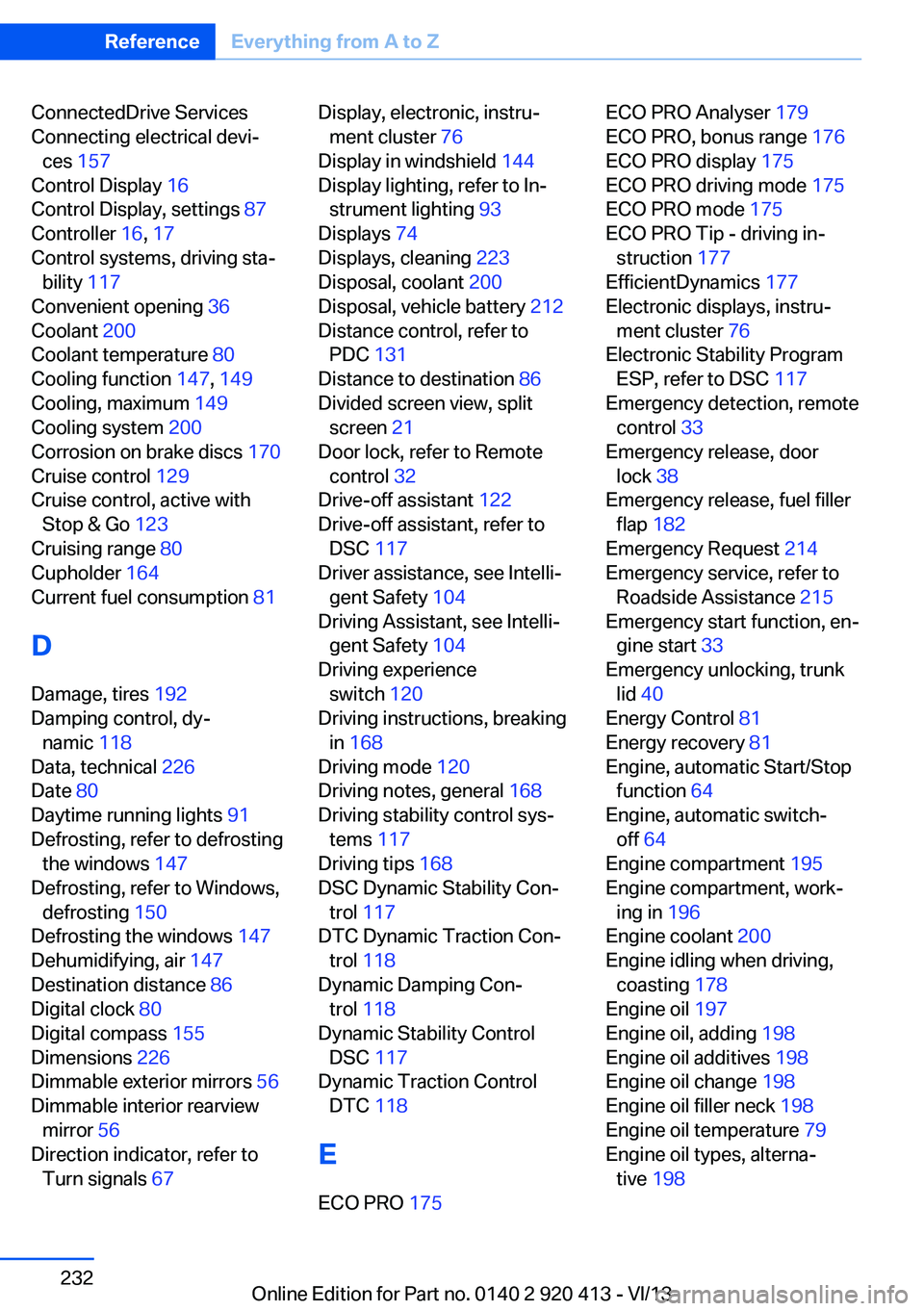
ConnectedDrive Services
Connecting electrical devi‐ ces 157
Control Display 16
Control Display, settings 87
Controller 16, 17
Control systems, driving sta‐ bility 117
Convenient opening 36
Coolant 200
Coolant temperature 80
Cooling function 147, 149
Cooling, maximum 149
Cooling system 200
Corrosion on brake discs 170
Cruise control 129
Cruise control, active with Stop & Go 123
Cruising range 80
Cupholder 164
Current fuel consumption 81
D
Damage, tires 192
Damping control, dy‐ namic 118
Data, technical 226
Date 80
Daytime running lights 91
Defrosting, refer to defrosting the windows 147
Defrosting, refer to Windows, defrosting 150
Defrosting the windows 147
Dehumidifying, air 147
Destination distance 86
Digital clock 80
Digital compass 155
Dimensions 226
Dimmable exterior mirrors 56
Dimmable interior rearview mirror 56
Direction indicator, refer to Turn signals 67 Display, electronic, instru‐
ment cluster 76
Display in windshield 144
Display lighting, refer to In‐ strument lighting 93
Displays 74
Displays, cleaning 223
Disposal, coolant 200
Disposal, vehicle battery 212
Distance control, refer to PDC 131
Distance to destination 86
Divided screen view, split screen 21
Door lock, refer to Remote control 32
Drive-off assistant 122
Drive-off assistant, refer to DSC 117
Driver assistance, see Intelli‐ gent Safety 104
Driving Assistant, see Intelli‐ gent Safety 104
Driving experience switch 120
Driving instructions, breaking in 168
Driving mode 120
Driving notes, general 168
Driving stability control sys‐ tems 117
Driving tips 168
DSC Dynamic Stability Con‐ trol 117
DTC Dynamic Traction Con‐ trol 118
Dynamic Damping Con‐ trol 118
Dynamic Stability Control DSC 117
Dynamic Traction Control DTC 118
E ECO PRO 175 ECO PRO Analyser 179
ECO PRO, bonus range 176
ECO PRO display 175
ECO PRO driving mode 175
ECO PRO mode 175
ECO PRO Tip - driving in‐ struction 177
EfficientDynamics 177
Electronic displays, instru‐ ment cluster 76
Electronic Stability Program ESP, refer to DSC 117
Emergency detection, remote control 33
Emergency release, door lock 38
Emergency release, fuel filler flap 182
Emergency Request 214
Emergency service, refer to Roadside Assistance 215
Emergency start function, en‐ gine start 33
Emergency unlocking, trunk lid 40
Energy Control 81
Energy recovery 81
Engine, automatic Start/Stop function 64
Engine, automatic switch- off 64
Engine compartment 195
Engine compartment, work‐ ing in 196
Engine coolant 200
Engine idling when driving, coasting 178
Engine oil 197
Engine oil, adding 198
Engine oil additives 198
Engine oil change 198
Engine oil filler neck 198
Engine oil temperature 79
Engine oil types, alterna‐ tive 198 Seite 232ReferenceEverything from A to Z232
Online Edition for Part no. 0140 2 920 413 - VI/13